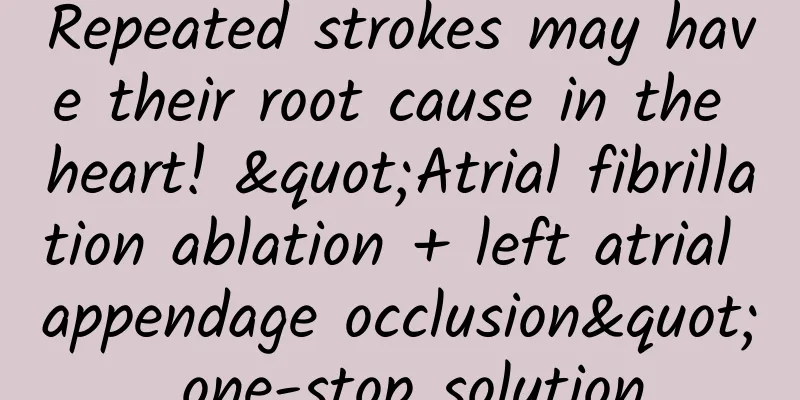Repeated strokes may have their root cause in the heart! "Atrial fibrillation ablation + left atrial appendage occlusion" one-stop solution

|
Recently, 61-year-old Uncle Xiong went to the Second People's Hospital of Hunan Province (Provincial Brain Hospital) for treatment because of his second stroke symptoms. He was also hospitalized for stroke in February last year. Uncle Xiong was very confused. Wasn't he cured last year? Why did he have repeated strokes? After a detailed examination by You Sanli, director of the Second District of the Department of Cardiovascular Medicine , it was concluded that the reason Uncle Xiong had two strokes was that he suffered from paroxysmal atrial fibrillation, which caused irregular heartbeats and inconsistent blood flow direction, easily generating vortices, leading to blood stasis and the formation of blood clots, and 90% of blood clots formed in the left atrial appendage. The left atrial appendage is a bay window-like area that protrudes outward from one of the four chambers of our heart, called the left atrium. Its inner wall has a lot of muscle tissue and is not smooth. It is the place in the heart where blood clots are most likely to form. Therefore, patients with atrial fibrillation are prone to stroke. The cause of repeated strokes has been found: atrial fibrillation causes blood clots in the heart's "floating window" to break off, which flow into the cerebral blood vessels and form blood clots, leading to strokes. To specifically solve the problem of repeated strokes, atrial fibrillation ablation and left atrial appendage closure are required. Director You Sanli carefully formulated an operation plan for Uncle Xiong and successfully completed the atrial fibrillation ablation and left atrial appendage occlusion. After the operation, Uncle Xiong's symptoms were relieved under active treatment, and the source of the blood clot was solved from the root. Director You Sanli introduced: This surgery is mainly suitable for patients with long-term atrial fibrillation, who have a high risk of thromboembolic events, but cannot take anticoagulants for a long time due to the high risk of bleeding, or who still have thromboembolic events despite taking anticoagulants for a long time. For such patients, left atrial appendage closure can effectively prevent the formation of left atrial appendage thrombus, thereby preventing acute cerebrovascular embolic events and other arterial embolism. The following are questions about left atrial appendage occlusion, answered by Dr. You Sanli: Q: How is left atrial appendage occlusion performed? A: A catheter is inserted into the femoral vein in the groin to enter the heart. The occluder is sent to the correct position of the left atrial appendage through the catheter and then released to block the entrance of the left atrial appendage. Q: Is left atrial appendage occlusion safe? A: It is relatively safe. The procedure has minor immediate risks. Its safety profile is similar to other routine catheter procedures. Q: Is left atrial appendage occlusion a lifelong solution? A: Yes. The occluder will block the left atrial appendage for life and does not need to be replaced. Question: Will atrial fibrillation be terminated after left atrial appendage occlusion? A: No. LAA closure is a method to prevent atrial fibrillation-related stroke, but it cannot treat atrial fibrillation. Therefore, atrial fibrillation ablation and LAA closure are often performed at the same time as a "one-stop" surgery. Q: Can I continue to play tennis, golf, and other sports after surgery? A: Yes. You only need to avoid strenuous exercise for a few days after surgery. There is no need to avoid sports or other high-intensity physical activities afterwards. Q: Is it possible for the occluder to fall off? A: It is very rare and controllable. The possibility of occluder migration after the healing period is extremely small.
(Edited by Wx) |
>>: Emergency consultation: Who sealed Shen Gongbao's throat?
Recommend
Can women eat placenta during menstruation?
Menstruation is a process that every female frien...
Why is the first day of menstrual blood dark?
Women's menstruation is a normal physiologica...
How to solve chest pain and lumps
Female friends may be more familiar with the situ...
When is the best time to do amniocentesis? Time is of the essence.
Many expectant mothers know about amniocentesis, ...
Six behaviors of women that are most damaging to breasts
Breasts are very important organs for women and a...
Cao Cao, “a capable minister in peaceful times and a hero in troubled times,” died of what disease?
The Yangtze River flows eastward, and the waves w...
How to maintain after hysterectomy?
There are many gynecological diseases in life tha...
How to maintain a healthy uterus?
With the continuous improvement of living standar...
How many days does it take for a female test tube transplant to implant?
In vitro fertilization is currently a very mature...
Why does my lower abdomen hurt?
Stomach pain can be said to be the most common sy...
What is the reason for IVF?
Generally speaking, women who undergo in vitro fe...
The woman who was thrown into bed wants to tell you some secrets
Regarding the question of women's minds, it&#...
Why are girls more likely to be hurt? It’s not because they are being coquettish or pretentious, they are really more afraid of pain!
One minute with the doctor, the postures are cons...
Can fetal “ultrasound major malformation screening” screen and diagnose “patent foramen ovale”?
Author: Zhao Fangui, Chief Physician, Obstetrics ...
Can I take a hot spring bath if I have vulvitis?
Gynecological diseases are a major threat to wome...









